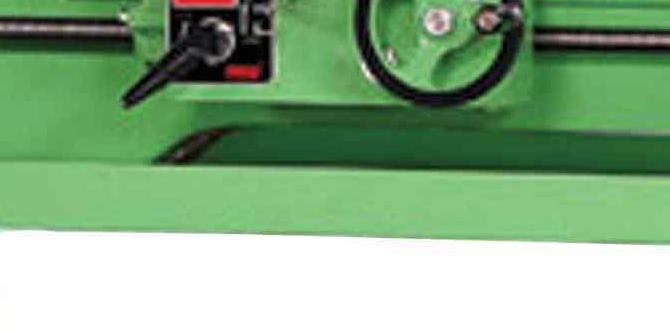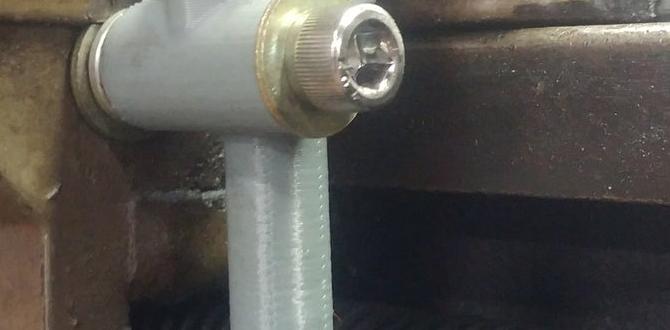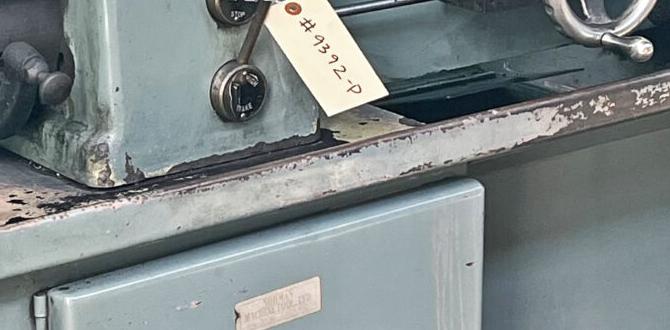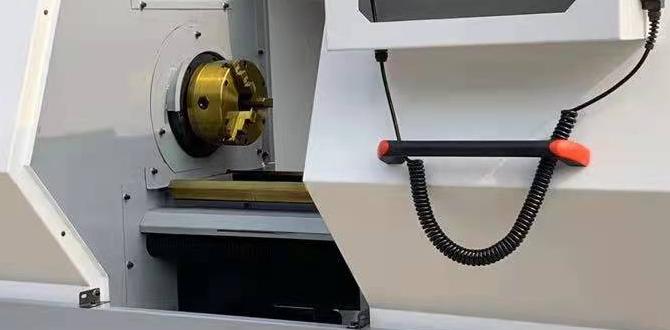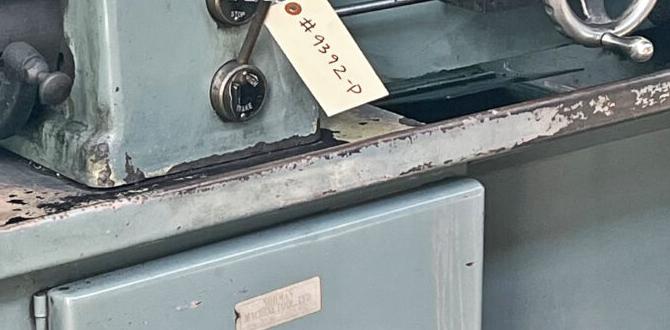Quick Summary: A wood lathe turning speed calculator is your go-to tool for instantly finding the safest, most efficient RPM for any woodworking project. It factors in wood type, diameter, and your lathe’s capabilities to prevent accidents and ensure smooth turning, making your projects successful and enjoyable.
Wood Lathe Turning Speed Calculator: Your Essential Guide
Ever stared at a beautiful piece of wood and wondered, “How fast should I spin this thing?” It’s a common question for anyone new to the wood lathe. Spinning too fast can be dangerous, leading to kickback or even broken tools. Spinning too slow means your work isn’t smooth, and you’ll have a lot more sanding to do. Finding that “just right” speed can feel like guesswork, but it doesn’t have to be. We’re going to demystify wood lathe turning speeds and show you how to use a simple calculator to get it right every time. This guide will give you the confidence to tackle any project, big or small, safely and effectively.
Let’s dive into making your woodturning experience safer and more productive. We’ll cover why speed matters, how to calculate it, and what factors influence your ideal RPM. By the end of this, you’ll be turning with precision and peace of mind.
Why Wood Lathe Turning Speed Matters
Imagine a race car driver. They don’t just floor it everywhere, right? Different tracks, different conditions, different cars – they all require different speeds. Woodturning is surprisingly similar. The speed at which your wood spins, measured in Revolutions Per Minute (RPM), is critical for several reasons:
- Safety: This is the big one. If the wood is spinning too fast, especially larger or unbalanced pieces, it can vibrate excessively, leading to dangerous kickback or even the workpiece breaking apart. Slower speeds are generally safer for beginners and for larger, irregular blanks.
- Ease of Cutting: The right speed allows your tools to shear the wood cleanly. Too slow, and your gouges and chisels will tear into the wood, leaving a rough surface that requires extensive sanding. Too fast, and the tool can “chatter” or skip, also creating an undesirable finish.
- Wood Type and Condition: Different woods have different densities and strengths. A hard, dense wood like oak can often be turned at higher speeds than a soft, open-grained wood like pine. The condition of the wood (wet, dry, cracked) also plays a role.
- Tool Performance: Your turning tools are designed to work best within a certain range of wood speeds. Using the correct RPM ensures your tools cut efficiently and don’t become prematurely dulled.
- Project Size: Larger diameter workpieces generally need to be spun slower than smaller ones. This is because the outer edge of a larger piece is moving much faster than the outer edge of a smaller piece at the same RPM.
Getting the speed dialed in minimizes tear-out, chatter, and increases your safety margin. It’s the foundation of good woodturning.
Understanding RPM and How It’s Calculated
RPM stands for Revolutions Per Minute. On your wood lathe, it’s how many times the spindle (and the workpiece attached to it) completes a full rotation in one minute. Your lathe might have a variable speed control, or it might have fixed pulley settings. Regardless, you need a way to determine the correct RPM.
While you can often find charts and tables with suggested speeds, a turning speed calculator takes the guesswork out by allowing you to input specific variables. The basic principle behind most calculators is a formula that relates the diameter of your workpiece to a desired cutting speed, and then converts that cutting speed back into RPM for your specific lathe.
The general formula looks something like this:
Cutting Speed = π x Diameter x RPM
Where:
- Cutting Speed is the linear speed of the wood’s surface (often expressed in surface feet per minute, or SFPM).
- π (Pi) is approximately 3.14159.
- Diameter is the diameter of your workpiece (usually in inches).
- RPM is the spindle speed.
To find the right RPM, you rearrange the formula:
RPM = Cutting Speed / (π x Diameter)
The key is knowing what a safe and effective “Cutting Speed” should be. This is where calculators and charts come in handy, as they provide those recommended cutting speeds based on wood type and operation.
Factors Influencing Your Wood Lathe Turning Speed
There isn’t a single “magic number” for turning speed. Several factors come into play, and a good calculator will account for them. Here are the main ones:
- Wood Diameter: As mentioned, larger diameters require slower RPMs to maintain a safe and manageable surface speed. A 12-inch bowl blank needs to turn much slower than a 2-inch spindle blank.
- Wood Type:
- Hardwoods (Oak, Maple, Cherry): Generally denser and can be turned at slightly higher speeds than softwoods, once shaped.
- Softwoods (Pine, Fir, Poplar): Softer, more prone to tear-out. Often require slower speeds, especially when starting with irregular blanks.
- Exotic Woods (Ebony, Wenge): Can vary greatly in density and grain structure. Always start slow and proceed with caution.
- Green (Wet) Wood vs. Dry Wood: Green wood is softer and can be turned at higher speeds initially. As it dries, it can become more brittle, and larger pieces might need slower speeds to avoid cracking.
- Wood Condition/Balance:
- Rough/Unbalanced Blanks: When you first mount a square or irregular piece of wood, it will be unbalanced. This causes significant vibration. You MUST start at the lowest possible speed and gradually increase it only as the wood becomes more round and balanced.
- Cracked or Damaged Wood: If wood has visible cracks or is damaged, err on the side of much slower speeds, or avoid using it altogether for higher speed operations. Reinforce cracks if possible and safe.
- Type of Operation:
- Roughing/Shaping: This is often done with larger gouges on initial, possibly unbalanced blanks. Slower speeds are essential.
- Finishing Cuts: As the piece becomes round and smooth, you can often increase speed for cleaner cuts, but always be mindful of the diameter.
- Sanding: Many woodturners prefer to slow down the lathe significantly for sanding, especially for the final grits. Too high a speed can create dust issues and heat.
- Specific Tool Use: Some tools might perform better at slightly different speeds. For example, using a parting tool to cut a deep groove might require a steadier, potentially slower speed than general scraping.
- User Experience and Confidence: As a beginner, it’s always best to start at a slower speed than the calculator might suggest, especially when learning your lathe’s behavior and your tool control. As you gain experience, you’ll develop a better feel for what works best for different situations.
How to Use a Wood Lathe Turning Speed Calculator
Using a calculator is straightforward and provides a much more precise answer than generic charts. Most calculators are available online, often on woodworking forums, tool manufacturer websites, or dedicated woodworking sites. Some excellent resources can be found through university extension sites that focus on wood science and technology, like those provided by The Ohio State University’s School of Environment and Natural Resources, which often touch upon machining properties of wood.
Here’s a general step-by-step process for using one:
- Find a Reputable Calculator: Search online for “wood lathe turning speed calculator.” Look for ones that offer explanations and references to safety standards.
- Measure Your Workpiece Diameter: Accurately measure the largest diameter of the wood you are about to turn. If you’re starting with a square blank, measure the diagonal. If it’s an irregular shape, use the largest dimension.
- Identify Your Wood Type: Determine if you’re working with a hardwood, softwood, or an exotic species. If unsure, it’s safer to treat it as a softwood or use the lower end of a general range.
- Select Your Operation: Choose the task you’re performing from the calculator’s options (e.g., roughing, spindle turning, bowl turning, sanding).
- Enter the Data: Input the diameter and select the wood type and operation.
- Get Your RPM: The calculator will output a recommended RPM range. Always pay attention to the suggested range, as it’s usually better to pick a speed within that range rather than an exact single number.
- Check Your Lathe: Some calculators might also ask for your lathe’s motor horsepower or pulley system to give more tailored advice.
- Start Slow and Listen: For unbalanced or rough blanks, ALWAYS start at your lathe’s absolute slowest speed regardless of calculator recommendations. As the wood becomes rounder, you can gradually increase the speed, listening for excessive vibration and watching for wobble. If at any point the lathe sounds or feels stressed, slow it down.
Example Scenario: Turning a Bowl Blank
Let’s say you have a 10-inch diameter bowl blank made of maple, and you’re in the roughing-out phase.
- You find an online calculator.
- You measure the blank: 10 inches.
- You know it’s maple (a hardwood).
- You select “Bowl Turning – Roughing.”
- You enter 10 for diameter and select “Hardwood.”
- The calculator might suggest a range of 800-1000 RPM.
Your Action: If the blank is perfectly round and balanced, you might start at 800 RPM. If it’s a freshly cut, slightly irregular blank, you’d start at your lathe’s lowest speed (perhaps 200-400 RPM) and slowly increase it as it becomes more round and stable, aiming for around 800 RPM once it’s fairly symmetrical.
Example Scenario: Turning a Spindle
You’re turning a chair leg, a small spindle project, with a maximum diameter of 4 inches, made of pine.
- Using the same calculator.
- Diameter is 4 inches.
- Wood is pine (a softwood).
- Operation is “Spindle Turning – Shaping/Finishing.”
- Calculator input: 4 inches, “Softwood.”
- Suggestion: 1500-2000 RPM.
Your Action: Since a spindle is generally mounted between centers and becomes more balanced as you turn, you could start at a moderate speed (e.g., 1000 RPM) and gradually increase to your desired speed within the recommended range, listening for any signs of vibration. For fine finishing cuts or sanding, you might even slow it down to 800-1200 RPM.
Recommended Cutting Speeds (SFPM)
Different sources and calculators use slightly different recommended cutting speeds (SFPM). These are guidelines, and personal experience will refine them. Here’s a general idea of what the “Cutting Speed” value might look like in various calculators and charts for different operations and wood types:
| Operation / Wood Type | Recommended Cutting Speed (SFPM) | Notes |
|---|---|---|
| Roughing (General) | 1000 – 2000 | Start low, especially with unbalanced blanks. Increase as wood becomes round. |
| Spindle Turning (Hardwood) | 2500 – 3500 | Surface speed for shaping and intermediate cuts. |
| Spindle Turning (Softwood) | 1800 – 2800 | Softwoods are more prone to vibration. |
| Bowl Turning (Hardwood) | 2000 – 3000 | For shaping the outside and inside of bowls. |
| Bowl Turning (Softwood) | 1500 – 2500 | |
| Sanding | 800 – 1500 | Lower speeds reduce dust and heat buildup during sanding. |
| Faceplate Turning (Platter) | 1800 – 2500 | Depends heavily on diameter and wood stability. |
Remember, these are general guidelines. Always prioritize safety and listen to your machine and the wood.
Calculating RPM Manually (If Needed)
If you don’t have immediate access to a calculator, or you want to understand the math, you can calculate it yourself. You’ll need to know your lathe’s maximum RPM and have a reference for recommended surface cutting speeds.
Let’s use the formula:
RPM = (Cutting Speed x 12) / ( π x Diameter)
Note: We multiply the cutting speed by 12 because the common units for cutting speed are surface feet per minute (SFPM), and we need to convert that to inches per minute to match a diameter measured in inches.
Manual Calculation Example:
You are turning a 6-inch diameter workpiece of cherry (hardwood) and want to do some shaping. A good cutting speed for this might be around 2800 SFPM.
- Diameter: 6 inches
- Cutting Speed: 2800 SFPM
- π: 3.14159
Calculation:
RPM = (2800 x 12) / (3.14159 x 6)
RPM = 33600 / 18.84954
RPM ≈ 1782
So, for a 6-inch cherry workpiece, a speed of approximately 1782 RPM would be suitable for shaping. You’d likely set your lathe to the closest available setting, perhaps around 1750 or 1800 RPM.
Using a Lathe Speed Chart
Many woodturners keep a speed chart handy. These charts are essentially pre-calculated values based on common diameters and wood types. Lathe manufacturers often provide recommended speed charts for their machines. You can also find many reputable charts from woodworking associations or magazines. For instance, the Woodworking Network provides resources and guides that often include safety information relevant to machine operation.
| Diameter (inches) | Softwood (RPM) | Hardwood (RPM) | Exotic/Dense (RPM) | Notes |
|---|---|---|---|---|
| 1″ – 2″ | 2000-3000 | 2500-3500 | 1800-2500 | Spindles, small turning tools |
| 2″ – 4″ | 1500-2500 | 1800-3000 | 1200-2000 | Spindle work, tenons |
| 4″ – 6″ | 1000-1800 | 1200-2200 | 800-1500 | Larger spindles, small bowls |
| 6″ – 8″ | 800-1300 | 1000-1800 | 600-1200 | Medium bowls, platters |
| 8″ – 10″ | 600-1000 | 800-1500 |

